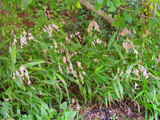Native Plants

Q. Who is Mr. Smarty Plants?
A: There are those who suspect Wildflower Center volunteers are the culpable and capable culprits. Yet, others think staff members play some, albeit small, role. You can torture us with your plant questions, but we will never reveal the Green Guru's secret identity.
Did you know you can access the Native Plant Information Network with your web-enabled smartphone?
Ask Mr. Smarty Plants is a free service provided by the staff and volunteers at the Lady Bird Johnson Wildflower Center.

rate this answer
Saturday - January 05, 2008
From: San Antonio, TX
Region: Southwest
Topic: Grasses or Grass-like
Title: Post freeze care for Texas native grasses
Answered by: Barbara Medford
QUESTION:
Can you tell me the best post-freeze care for Tx native grasses in my garden: lindheimer muhly, gulf muhly, inland sea oats. Mexican feather grass. Do I cut them back? Burn them? Leave them alone? Thank you.ANSWER:
The key word in your question is "native." When you select plants that are already adapted to an area, it cuts down on the maintenance that has to be done. Muhlenbergia lindheimeri (Lindheimer's muhly), Muhlenbergia capillaris (hairawn muhly), Chasmanthium latifolium (Inland sea oats), and Nassella tenuissima (finestem needlegrass) are all native to this area, and will suffer little, if any, from frost. With all grasses, the main concern in trimming is keeping them tidy. It's probably best to leave any dead stems on the grasses until the chances of frost are well over, as the overhanging grasses will help to protect the green part of the plant from an excessive freeze. Then, you might cut about 1/3 of the plant back, and thoroughly rake out any dead or cut ends. Keeping the dead grasses out of the plants is important both to appearance and because the dry material can be a burn hazard. Obviously, we do not advise that you burn anything, especially now with the dry weather in Central Texas, along with high winds.
More Grasses or Grass-like Questions
Grass identification books for Texas
July 17, 2010 - We live northwest of Austin, on Nameless Road. Have MANY types of native grasses--can you recommend a good book, with photos, to use in identifying? Also, what native grasses are good for attracting...
view the full question and answer
Texas native plants for cemetery site
February 09, 2005 - I am trying to landscape my mothers gravesite located in far East Texas (just outside of Nacogdoches) and I am looking for some evergreen bushes or any other decorative plants for that area. I am thi...
view the full question and answer
Flowering Deer Resistant Ground Cover for Dry Rocky Soil: Alabama
March 26, 2012 - My question has been partially answered in the FAQ but I live in Birmingham where the soil is clay and rocky so it's a little different. I want to plant on a rocky slope (small rocks like the size of...
view the full question and answer
Surface tree roots hurting grass in Houston
March 21, 2013 - We have 2 mature Arizona Ash trees in our yard (30-40'). One of them is in a sunnier location and has developed an extensive network of surface roots (up to 1 to 1 1/2" Dia.) between the tree and th...
view the full question and answer
Plants for a Narrow Fence Line in TN
February 03, 2015 - I have a very specific and difficult planting question. I have a narrow strip (about 2 feet at the widest) between my back privacy fence and a wire fence that marks the edge of my property. It is dire...
view the full question and answer
| Support the Wildflower Center by Donating Online or Becoming a Member today. |

